In a previous post some time ago, I presented the structure called System of Systems (SoS) as the one at the top of complexity scale in the organizational systems. I described it as one where:
- there is no clear success criteria;
- the context is open or changing;
- there is no universal recipes guaranteeing the success;
- one needs to design to maintain continuous quality or it will not survive;
- there is multiple changing or conflicting goals;
- it is not possible to build a full scale prototype;
- there is limited ability to predict the outcome of any change;
- experimentation as the only option to make educated decisions.
In this same post, I also remembered the point that we need some level of complexity to build anti-fragile systems – ones that get better as they are exposed to adverse conditions. Some exploration is needed, pure exploitation is fragile and creates a risk of being put out of balance or ‘disrupted’ and rendered irrelevant by changes in the environment.
Still, maybe we want to avoid too much complexity as it is not without causing a number of problems.
Feeling at home? That is today’s business world.
In the present post, I will attempt to articulate an idea that emerge from my readings: Platforms are great to organize the mess we live in.
How have we ended up here?
Let’s first paint a picture of today’s world for a company.
Development of technology and its broad availability has lower the barrier for new competitors to enter pretty much any market.
Think about: opensource, the Internet, availability of broadband, cloud computing…
For many businesses, any technology they need is readily available and can be composed to enter an existing market. Granted this is bit more work that I made it sound, but it is definitively getting easier everyday and someone can decide to attack a part of any value proposition by getting better on a specific dimension.
This movement is called unbundling and has already disrupted numerous markets where one bundled value package is no longer compelling, and the market offers customers to decide to take just the part they want. Competition is getting sharper.
In addition to more tools, exchanges are also accelerating and densifying.
The lack of low-delay and high-throughput communication channels used to create some distance between remote places. Now, that world has become interconnected and distance no longer creates delay. The damping effect of distance not being present anymore, we live in a world where changes are propagating globally and rapidly. This creates a more dynamic and complex environment. The competitor down the street is not the only one a company need to worry about. A new market opening on the other side of the world might be an opportunity not to be missed.
The competitive pressure and the overall number of participants building things created a richer environment with more everything: technologies, options, needs, constraints, qualities we care about, and more. This also leads to more fragmentation with resources – time, money, head count – needing to be allocated in more buckets, and more dependencies – again complexifying the picture.
On the topic of adaptations, time or lack thereof, this feeling of acceleration is not new Acceleration through Digital Communication: Theorizing on a Perceived Lack of Time, E. Entschew and might even be the result of the coevolution of competitive entities Red queen hypothesis.
So more and accelerating competitive pressure, more interconnected and dynamic environment and fragmentation of the resources, the perspectives look great.
Attention deficit
‘Progress’ is expected to bring productivity gains as in doing more with the same amount of resources. But it also creates fragmentation. Real activities are not infinitively divisible, and at some point, the sum of the context-switching cost – due to nonlinearities – can exceed productivity gains.
What if companies had too become victims of the attention economy as we, individuals, have? After all, the attention is a finite pool of resources that can be divided between several tasks but not infinitively.
In an hyperconnected world, attention has become a common good: the rivarly was given, the loss of excludability is the result of the multiplication of channels and interactions created by the increase in competition and connectedness. With the structure we pictured previously, the tragedy of the commons sounds near - see similar analysis in the context of the ‘knowledge workers’ The Tragedy of the Attentional Commons - In Search of Social Rules for an Increasingly Fragmented Space, D. N. Wagner:
- finite sum of attention available for different activities - ‘attention space’ in the paper,
- selfish interest of participants consume attention.
Competition consumes companies attention directly (e.g. getting other’s attention to sell) and indirectly by creating more front for them to fight on. How to escape this?
Focus - Platform to the rescue of SoS
Recent years have seen the emergence of many multi-sided platforms. They must be a solution to something.
I believe they actually solve three problems:
- the need for innovation to be isolated the noise of doing business,
- the need for an effectient and fair intermediation between producer and consumers,
- the need for specialization to be competitive and provide a pattern to decompose the complexity of the System of Systems.
At this point, this is a conjecture. Allow me to explain my current thoughts.
Market modularization
A common architectural pattern to tame complexity is modularization. That is creating boundaries and mechanisms to support: separation and recombination. The idea of separation is to ensure only the ‘valid’ concerns cross the boundaries, and the recombination is to allow the different modules to cooperate to solve bigger problem. With that structure in mind, a large problem can be solved as a combination of smaller problem1.
What could it look like?
- there must be consumers,
- innovation need to happen somewhere to find new solution and adapt to changes,
- access to a market to transact with others,
- compose being able to solve end to end – and sometime unique – problems,
Let’s look at the components and their interfaces in the next two sections.
Specialization
We see specialization as both a way to clearly define the mission and the boundaries. In the proposed view of the world, there are the following roles:
- consumers,
- innovators (or producers),
- platforms,
- aggregators.
Consumers can consume from aggregators, platform and innovators. But platforms offer matching mechanisms to select the best innovator for the job. Aggregators build customized solutions from a combination of goods made available by a platform or innovators.
In this model, the missions are clear: the consumer consumes - and pay for what they consume; the aggregator assembles custom solutions, the innovator produces new goods and finally the platform offers a place where good can be exchanged.
A platform facilitates the exchange and make the best match between consumers and innovators or they will go to another platform or transact directly, and the platform will not get any commission.
A company or an individual can assume multiple roles and for example be a consumer of some goods and use these to innovate and produce some other goods; or a company can be a platform owner and host of several innovators selling on that platform, while having a professional services division building custom solutions to address specific needs.
Here are a couple of examples, starting with a producer selling directly to its consumers:
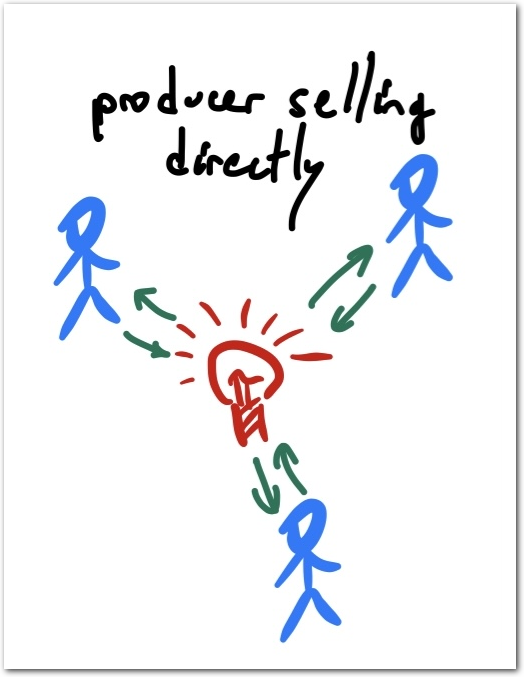
A consumer building his own solution by aggreging from multiple producers:
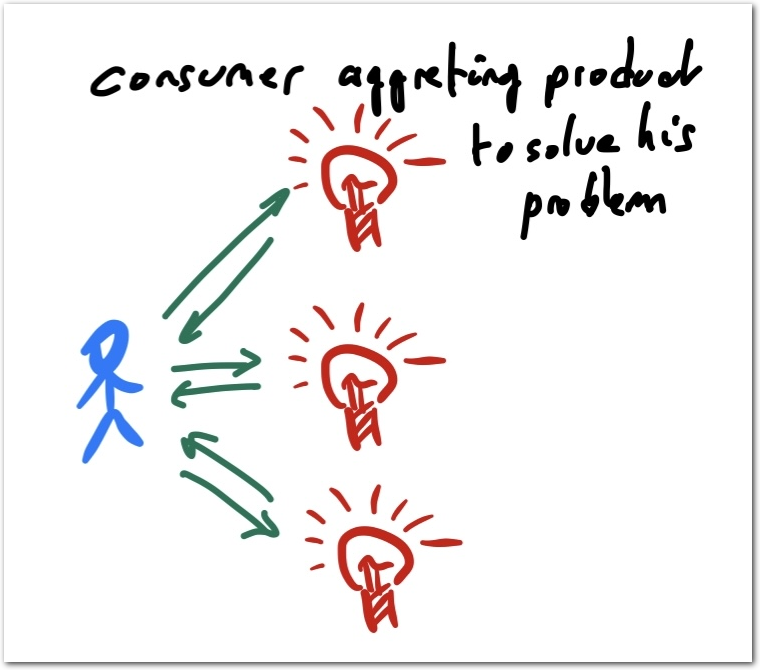
An aggregator doing the same for a consumer:
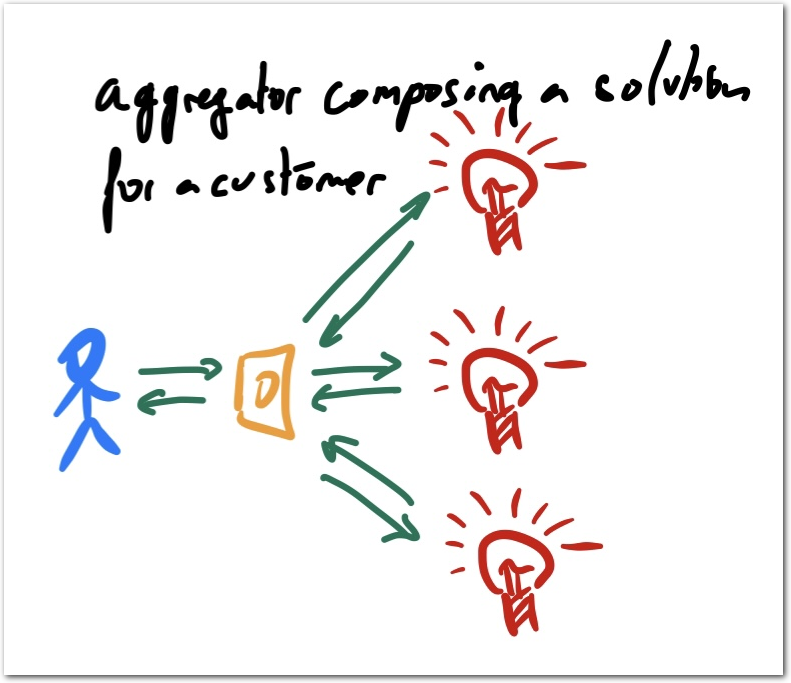
Finally a platform:

Now let’s talk about the boundaries, and interfaces.
Boundaries and Interfaces
A remarkable property of a platform is that it doesn’t need to understand what the consumer is trying to achieve. Only what the consumer is looking for matters!
If you think in term of ‘gains/pains/missions’ from Value Proposition Design, A. Osterwalder, you can ignore the missions. BTW don’t try that if you are in a pipeline business.
I would actually go further and emit the idea that the attributes that define the ‘pains’ and ‘gains’ need just to be made explicit in the description of the unit being negotiated between the consumer and producer through a platform and the producer will ‘learn’ (through experimentation or natural selection) what consumers are typically looking for and adjust – or disappear.
Since the object of a platform is to faciliate the transactions and for this the matching between consumers and producers, they tend to ‘standardize’ the value being exchanged: both in term of description, what is being delivered, but also ‘how’ it gets delivered as we will discuss later. Allowing too much specifities would fragment the market and reduce the cases where a match is possible.
So the boundaries must be pretty clear now:
- the consumer is looking for something to achieve its mission but doesn’t need to tell what the mission is and can only describe what he is looking for.
- the platform needs a description of what is available (from the producers) and what consumers are looking for,
- the consumer describe what he can deliver in the way the platform told him to,
- the aggregator can have a more complex relationship with its customer but on the ‘provider’ side will just act as a consumer.
Let’s talk a little bit about the different types of costs and who is facing what before going to the interfaces.
- Transaction cost is the cost of doing ‘business’: the cost of find a peer, negotiating, agreeing, doing the exchange of value/money, and covering for the associated risks,
- Coordination cost is the cost of acting as a market-maker and organizing the exchanges: onboarding the participants, building and maintaining the listings and the ‘platform’, matching offers and demands,
- Innovation cost is the cost of doing something novel or different from the other producers.
A producer faces its share the transaction cost and the innovation cost. The lower the transaction cost, the more competitive he can be. A consumer faces its share of the transaction cost. The aggregator faces: transaction cost, and some coordination and innovation if we assume it is going to different platforms, comparing ways to ‘combine’ what can be found there in order to meet his customer requirements. A platform faces the coordination cost.
A platform aims at hosting more transactions and for that need to lower the transaction cost as much as possible – possibly subsidizing one side that would not otherwise participate at all. The standardization of the interface it is offering both to producers and consumers is a way to ‘simplify’ and reduce the cost of transaction. Note that there can be a lot more than just an API call here – think about arranging a delivery or the storage of something voluminous and fragile, that’s definitively something of a nature of making a transaction possibly painful and unlikely to happen.
Consumer and producer that want to participate to given platform will need to adhere to its interfaces. One platform has no interest using the same interface as another platform as it would facilitate the competition between platform and help its participants to switch to another platform – maybe that other platform is taking a smaller cut on the transactions. We can safely assume that there are far less platforms as producers or consumers and if it is so, joining a platform is beneficial for them in that they will need to adopt fewer interfaces lowering the transaction cost (and ‘lock-in’) as compared with doing business directly.
On the competition between platforms front, since they need to remain relevant and offer interactions that are useful, and compete for that, platforms are pushed to adapt to the market conditions and offer new interactions.
Lastly, for a consumer to switch to another producer on the same platform is very easy by the very objective of the platform and naturally achieve through the ‘matching’ between consumer’s demand and producer’s supply.
To conclude this section, platforms, by their very nature, make it easy to integrate with them and to switch to another producer. Doing so, they provide easy recombination of what is being offered and faciliate reconfiguration when needs change – aggregator can do this too but at a greater cost – less standardization, more customization.
Equipped with this understanding on the different types of module and their interfaces, let’s now get back to the attention.
Attention
Let’s start with the 3 points mentionned at the beginning of this section to advertise platforms as a way to bring focus.
First, a platform plays the role of intermediation between the consumers and producers (innovators); it provides the mechanisms to describe what there is to be consumed, it does the matching based on the consumer criteria and provide the interface for the producer to deliver. Doing so, it is isolating the producer from the ‘noise of doing business’ which can therefore focus on innovation.
Second, although a platform in its position of market maker can distord the concurrence and be unfair to some producers or consumers, it is unlikely. Since a platform get paid by the number of transaction it hosts, one of the critical aspect it needs to address is building trust with its participants so they interact again and again, being unfair would not help here. Also, competition between platform is very possible – it is actually called multihoming.
Third, the decomposition we proposed allows the producer, aggregator as well as the platform to specialize in just doing that. Sure they can do more than on role, but that don’t have too.
Now, two new points that emerged from the discussion.
Platforms reduce the number of interconnections in the system required to deliver support the same abilities: from the product to the sum of the number of producers and the number of consumers.
Without a platform:
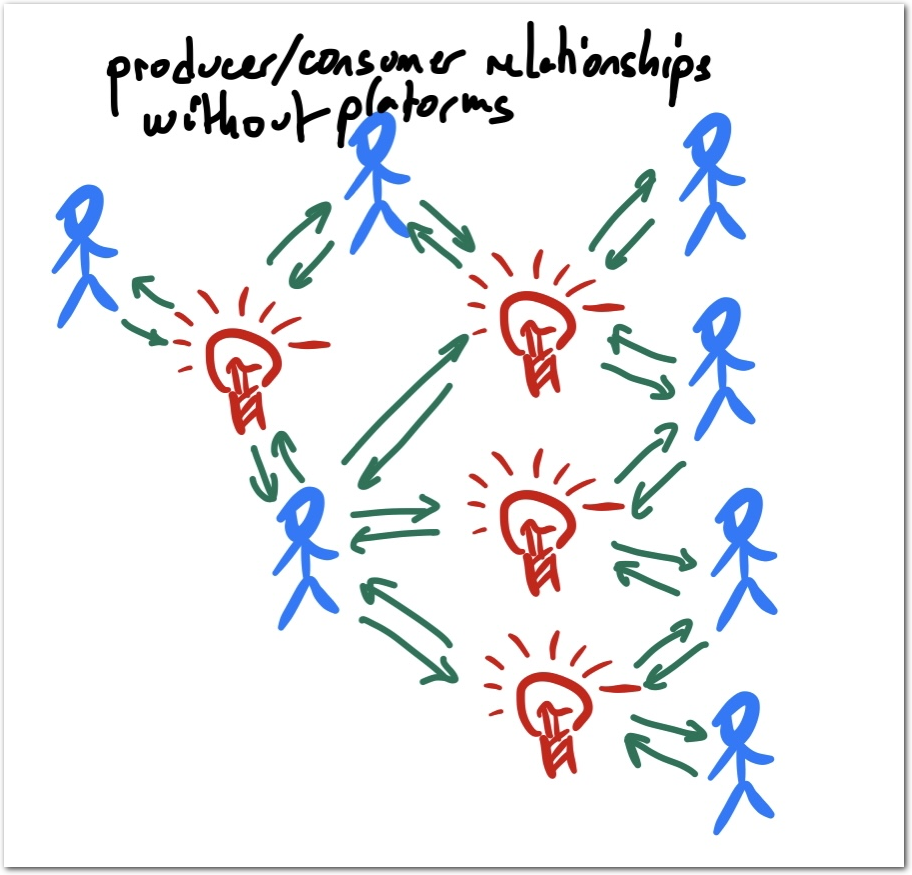
With a platform:
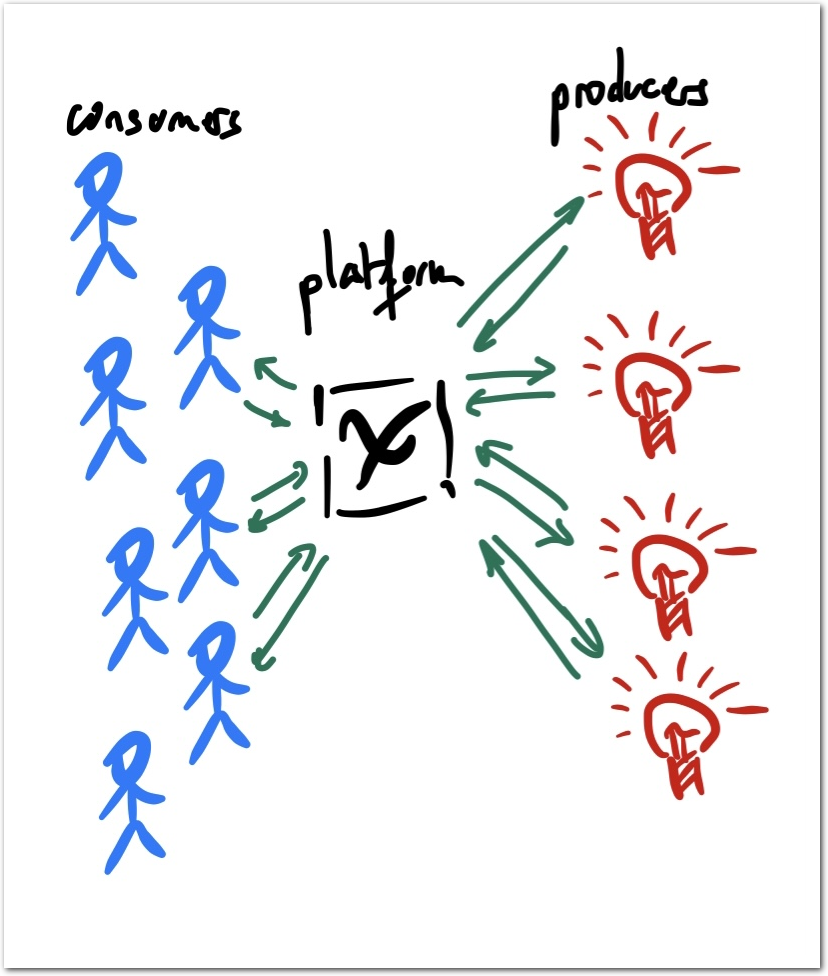
And finally, consumers and producers rely on more stable – long-lived – connections with platforms rather than ephemeral end-to-end connections. One of the benefit in term of attention for example is that this enables the producer and consumer to rely on their trust of the platform rather than worrying about building mutual trust – another resource consuming effort.
Conclusion
SoS seems to be a pretty good model of the real world and its level of complexity. Attention is concern for individuals and companies. Platforms are here. Is that because they actually help in some way? Are those the one listed above? Maybe. Maybe this is just some sort of soup.
Would be nice to try to simulate these behaviors and see what happen. Might deserve putting some code at work here. Will see. In any case, definitively a mix of fascinating subjects. In case you wonder, I don’t do drugs but might have spent a bit too much time on Factorio and other RTS. In any case, remember to have fun!
References
- Platforms are eating the world, Forbes,
- Platform Revolution: How Networked Markets Are Transforming the Economy and How to Make Them Work for You, G. G. Parker et al,
- Platform Scale: How an emerging business model helps startups build large empires with minimum investment, S. P. Choudary,
- “Yegge’s rant” (copy of),
- Value Proposition Design, A. Osterwalder,
- Acceleration through Digital Communication: Theorizing on a Perceived Lack of Time, E. Entschew,
- Layering as Optimization Decomposition: A Mathematical Theory of Network Architectures, S. Low et al,
- The Tragedy of the Attentional Commons - In Search of Social Rules for an Increasingly Fragmented Space, D. N. Wagner.
A paper that blew my mind during my PhD: Layering as Optimization Decomposition: A Mathematical Theory of Network Architectures, S. Low et al↩︎
